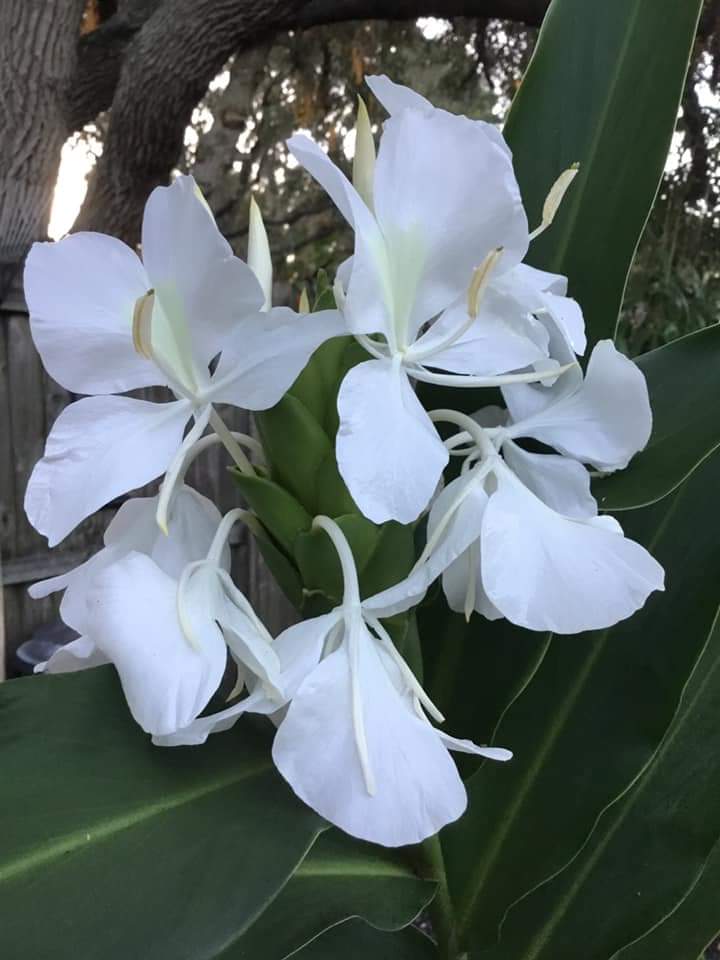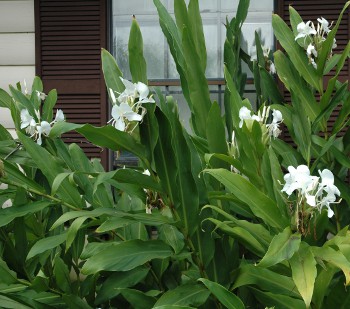S & J Nursery’s Guide to Growing Butterfly Ginger
for Northeast Florida, Jacksonville | St. Augustine area Landscapes
( Hedychium Coronarium )
Hedychium Coronarium Butterfly Ginger Origins:

– Natives of Asian forested areas the Butterfly Ginger Hedychium coronarium has long been a personal garden favorite of mine for the North Florida area. Fragrant clusters of white blossoms in late summer and fall will perfume the entire yard. The graceful blooms look like butterflies in flight and unlike many ginger species the Butterfly Gingers blooms are very visible as they stand atop the foliage on the tall plant stems.
Butterfly Ginger Preferred Exposure:
– Plant Hedychium Coronarium Butterfly Ginger in a full sun to shaded location in the North Florida | Jacksonville | St. Augustine area landscape. Hedychium Coronarium Butterfly Ginger does well in a sunnier location as long as it is planted into a moist garden site. If your garden is extremely sandy and dry consider planting it in a location that will receive some relief from North Florida’s hot sun.
Butterfly Ginger Foliage:
– Upright stalks of shiny green foliage are attractive fillers in indoor
arrangements although the blooms themselves will not hold once cut from the plant.

– Foliage may remain evergreen during the winter in our North Florida area gardens, but can go dormant and come back rapidly the following spring depending on winter conditions and exposure.
– Gingers are a rhizomatious perennial plant, that is they grow and spread from underground rhizomes ( thick stem like roots, very similar to the more familiar Iris family of plants ) and form clumps of foliage.
Hedychium Coronarium Butterfly Ginger Soil Preference / Salt tolerance:
– Butterfly Ginger is tolerant of a wide range of soil components and growing conditions, although they will be most at home with adequate moisture and rich fertile soils will allow these plants to thrive and quickly form a mature clump.
– Salt tolerance unknown.
Hedychium Coronarium Butterfly Ginger Size Variance:
– The foliage on the Butterfly Ginger plant will reach 5-6 ft high and 4-5 ft
wide.
Hedychium Coronarium Butterfly Ginger Growth Habit:
– Clumping perennial rhizomes forms an attractive, upright mound of tropical foliage that stands erect and gently arches at its edges and under the weight of the late summer to fall blooms.
Butterfly Ginger Growth Rate:
– Fast growing Ginger selection will reach maturity in an ideal garden location in its second season in the ground, if your ginger plant is not taking off after its first year in the ground consider amending the area generously with compost and adding supplemental irrigation.
Hedychium Coronarium Butterfly Ginger Bloom:
– Huge bloom clusters of large white highly fragrant flowers stand on tips of
foliage stalks from August to October and can perfume the entire garden! Smell one and your hooked, a must have plant for the avid gardener.
Butterfly Ginger Water Requirements:
– Although much more durable once established in the landscape, regular water is necessary to get the plant rooted and growing on its own after being planted in the ground from an S & J Nursery container. Use supplemental irrigation when planted in drier soil situations.
Best Uses For Butterfly Gingerin the Jacksonivlle | St. Augustine Area Landscapes
:
– Butterfly Ginger is a great easy care low maintenance addition to just about any landscape.
– Plant them as the backdrop to a mixed perennial border for added tropical
appeal.
– Plant height lends itself to covering unsightly garden sheds fences or pool
pump areas etc.
Care of Butterfly Ginger:
– Low care landscape pant selection in rich soils. Ammend soil generously
whith compost or cow manure when planting for best results.
– Water every day during the establishment period after planting in the garden from an S & J Nursery container.
– Ginger plants will need not only good water during the establishment period and supplemental irrigation during dry spells or particularly hot dry summers, especially when planted into sandier soils.
– Fertilize each spring with a handful of garden compost or a mixture of Milorganite or Green Edge Fertilizer and a slow release poly coated plant food such as Osmocote or Stay Green general purpose plant food or 10-10-10.

